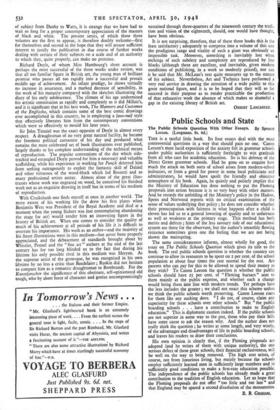Black and White Doyle. By Dana Hambourg.—Tenniel. By Frances Sarzand.
Cruikshank. By Ruari McLean. English Mastem of Black and White. (Art and. Technics. 8s. 6d.)
A corrvrNaNG argument could be evolved in favour of the view that the reputation of British art is most worthily maintained by our illustrators. If the twin peaks of Turner and Constable are tactfully skirted as being isolated eminences standing apart from the main range, few of the remaining heights overtop the great ridge of our graphic artists. Hogarth, Rowlandson, Blake, Cruikshank, Keene are, it could well be maintained, the true giants in our tradition, and even so, at first sight, pure an artist as Sickert was at his best in those etchings which, for all their detachment, retain a funda- mentally literary content and those final paintings in which he paid homage to Sir John Gilbert. At a time when-a passion for reassessment 'has produced an apparently inexhaustible flood of publications ranging in their choice of subject from Danby to Watts, it is strange that we have had to wait so long for a proper contemporary appreciation of the masters of black and white. The present series, of which these three volumes are the first to appear, is therefore doubly welcome—first for themselves and second in the hope that they will arouse sufficient interest to justify the publication in due course of further works dealing with certain of their subjects on a scale and of an authority to which they, quite properly, can make no pretence.
Richard Doyle, of whom Miss Hambourg's short account is perhaps the most successful of the three works under review, was that all too familiar figure in British art, the young man of brilliant promise who passes all too rapidly into a successful and prosaic middle age of achievement. An infant prodigy, he shows virtually no increase in assurance, and a marked decrease of sensibility, in the work of his maturity compared with the sketches illustrating the diary of his early adolescence. The climate of his age undermined his artistic constitution as rapidly and completely as it did Millais's, and it is significant that in his best work, The Manners and Customes of the Englisshe, which contains some of the best comic drawings ever accomplished in this country, he is employing a faux-naif style that effectively liberates him from the contemporary conventions which were so effectively to mould his later years.
Sir John Tenniel was the exact opposite of Doyle in almost every respect. A draughtsman of no very great natural facility, he became the foremost political cartoonist of his day and produced what remains the most celebrated set of book illustrations ever published, largely thanks to his complete understanding of the technical means of reproduction. The popular conventions of the day which side- tracked and entangled Doyle proved for him a necessary and valuable scaffolding, while his experience in working for Punch deterred him from seeking outrageously to exploit the fantastic skill of Dalziel and other virtuosos of the wood-block which led Rossetti and so many professional artists astray. Almost alone of the great illus- trators whose work was engraved on wood, he conceived his finished work not as an exquisite drawing in itself but in terms of his medium of reproduction.
With Cruikshank one finds oneself at once in another world. The mere extent of his working life (he drew his first plates when Benjamin West was President of the Royal Academy and died at a moment when the young Sicken was just contemplating abandoning the stage for art) would render him an interesting figure in the history of British art. When one comes to consider the quality of much of his achievement at all periods of his life it is difficult to overrate his importance. His work as an etcher—and the majority of his finest illustrations were in this medium—has never been properly appreciated, and the debasement of standards brought about by Whistler, Pennel and the "fine art "' etchers at the end of the last century has for too long blinded us to the fact that during his lifetime his only possible rival in this medium was Meryon. As the supreme artist of the grotesque, he was recognised in his own lifetime by no less a critic than Baudelaire ; Ruskin did not hesitate to compare him as a romantic draughtsman to Rembrandt. For the Kunstforscher the significance of this obstinate, self-opinionated old tough, who by sheer force of character and genius uncompromisingly sustained through three-quarters of the nineteenth century the tradi- tion and vision of the eighteenth, should, one would have thought, have been obvious.
It is not surprising, therefore, that of these three books this is the least satisfactory ; adequately to compress into a volume of this size the prodigious range and vitality of such a giant was obviously an impossible task. Moreover, something is inevitably lost when etchings of such subtlety and complexity are reproduced by line blocks (although these are excellent, and inevitable, given modern conditions of publishing, in a work so modestly priced), nor can it be said that Mr. McLean's text quite measures up to the stature of his subject. Nevertheless, Art and Technics have performed a very real service in drawing the attention of a wide public to this great national figure, and it is to be hoped that they will so far succeed in their purpose as to render practicable the production of that exhaustive work the absence of which makes so shameful a gap in the existing library of British art.
OSBERT LANCASTER.































 Previous page
Previous page